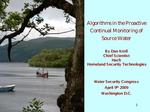Description
Recent research has suggested that certain nitrogenous (N)-disinfection byproducts (DBPs) (e.g., HANs) andcertain non-regulated carbonaceous (C)-DBPs (e.g., HAs) may be of higher health concern thanthe regulated C-DBPs (e.g., THMs, HAAs). The U.S. Environmental ProtectionAgency’s (USEPA’s) Integrated Risk Information System (IRIS) database indicates that for eightnitrosamines (including NDMA) drinking water concentrations in the low ng/L level areassociated with a 10-6 lifetime cancer risk. EfOM and AOM are sources of disinfection byproduct (DBP) precursors,especially for N-DBPs. Thus, a survey was conducted to look at N-DBP formation and that ofselected C-DBPs at 16 DWTPs, with a focus on wastewater and algal impacted drinking watersupplies.The authors conducted a full-scale survey of 16 U.S. drinking water treatment plants (DWTPs) in 2006 and/or 2007. Someof the sites were sampled during an algal bloom event. In terms of the effluent-impacted sites,they were sampled in the summer when river flow was low, as some streams can be moreeffluent-impacted at this time of year. In some watersheds, a DWTP that was not algal orwastewater impacted was sampled to provide a contrast. DWTPs were sampled that used a rangeof treatment processes (coagulation, lime softening, ultrafiltration, filtration with granularactivated carbon) and disinfectants (chlorine, chlorine dioxide, chloramines, ozone, ultraviolet). The paper provides analytical parameters. Includes 28 references, tables, figures.
Product Details
- Edition:
- Vol. – No.
- Published:
- 11/01/2008
- Number of Pages:
- 11
- File Size:
- 1 file , 790 KB
- Note:
- This product is unavailable in Ukraine, Russia, Belarus





